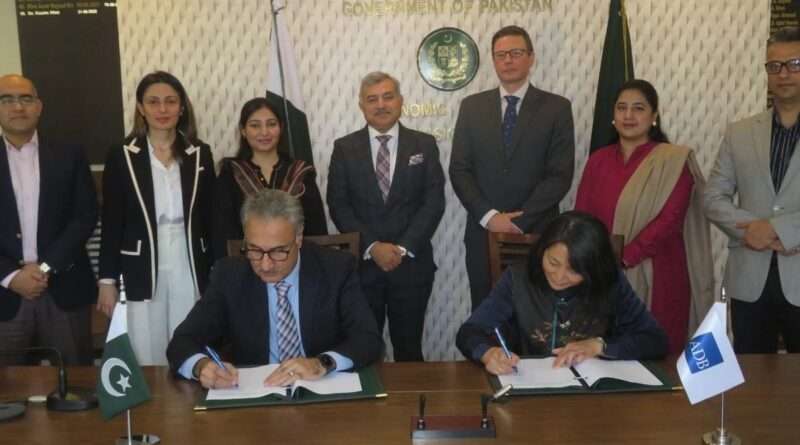Pakistan Signs $500 Million Loan Agreement with ADB for Climate Resilience
|
Getting your Trinity Audio player ready...
|
In a landmark development, Pakistan has signed a $500 million loan agreement with the Asian Development Bank (ADB) under the ‘Climate and Disaster Resilience Enhancement Program.’ This agreement reflects Pakistan’s commitment to strengthening its capacity to tackle climate change and manage the risks associated with natural disasters.
With this initiative, Pakistan moves closer to achieving its climate adaptation goals while reinforcing its institutional frameworks for disaster risk management. Below is a detailed analysis of this crucial development and its implications for Pakistan’s climate future.
The Agreement: A Landmark Step Towards Climate Resilience
The $500 million loan agreement is part of a broader strategy by Pakistan to address vulnerabilities exacerbated by climate change. The program focuses on enhancing disaster risk management, improving institutional frameworks, and integrating gender-sensitive public investments.
Why This Program Matters
Pakistan ranks among the most vulnerable countries to climate change, according to the Global Climate Risk Index. Frequent floods, rising temperatures, and unpredictable weather patterns have severely impacted its economy, agriculture, and infrastructure.
The Climate and Disaster Resilience Enhancement Program aims to address these vulnerabilities by:
- Strengthening Disaster Risk Management: Improved disaster risk mapping and coordinated response mechanisms will be developed.
- Enhancing Institutional Frameworks: Bolstering policies and systems to manage climate adaptation effectively.
- Focusing on Gender-Sensitive Investments: Ensuring that public investments in disaster management also address gender disparities.
Key Objectives of the Program
The program serves as a critical step towards scaling up disaster resilience in Pakistan. Here’s a breakdown of its primary objectives:
1. Improved Disaster Risk Management
Pakistan aims to develop robust systems for disaster risk mapping, monitoring, and response coordination. By employing advanced technologies and methodologies, the country seeks to minimize losses caused by natural disasters.
2. Climate Adaptation Policies
The agreement emphasizes the importance of institutionalizing climate adaptation policies to create long-term resilience. These policies will integrate climate risk assessments into national development plans.
3. Gender-Sensitive Public Investments
A unique aspect of this program is its focus on gender inclusivity. Women and vulnerable groups will play a vital role in disaster preparedness and response strategies, ensuring a more equitable approach to resilience building.
Economic and Policy Implications
Economic Affairs Minister Ahad Cheema highlighted the significance of the agreement in scaling up disaster risk financing and prioritizing climate initiatives.
Scaling Disaster Risk Financing
This program will enable Pakistan to mobilize resources for disaster risk financing, allowing it to address climate vulnerabilities without overburdening its economy.
Policy Alignment with Global Climate Goals
The initiative aligns with Pakistan’s commitments under the Paris Agreement and the UN Sustainable Development Goals (SDGs). It serves as a model for integrating climate adaptation into national policies and international collaborations.
Prime Minister’s Vision: The Global Call for Climate Finance
Prime Minister Shehbaz Sharif, addressing the UN COP29 climate summit, emphasized the need for enhanced global climate financing. According to him, developing nations like Pakistan require an estimated $6.8 trillion by 2030 to implement key climate actions under the Paris Agreement.
This loan agreement with the ADB is one of several steps Pakistan is taking to mobilize climate finance. It follows the government’s $1 billion request from the IMF’s Resilience and Sustainability Trust, aimed at supporting climate adaptation and clean energy transitions.
The Role of ADB in Pakistan’s Climate Strategy
The Asian Development Bank has been a long-standing partner in Pakistan’s development journey. Through this program, the ADB reinforces its commitment to helping the country build resilience against climate-induced challenges.
Key Features of ADB’s Support
- Technical expertise for disaster risk mapping and monitoring.
- Financial assistance to support climate adaptation policies.
- Capacity-building initiatives to strengthen institutional frameworks.
Challenges and Opportunities
While this loan agreement represents a significant milestone, Pakistan faces multiple challenges in implementing the program effectively.
Challenges
- Institutional Weaknesses: Ensuring coordination among various government agencies will be critical.
- Limited Resources: Mobilizing additional funds to complement the ADB loan is essential.
- Climate Awareness: Educating communities about climate risks and their role in resilience-building remains a challenge.
Opportunities
- Job Creation: Implementation of the program will generate employment opportunities, especially in disaster management and climate adaptation sectors.
- Technological Advancements: The use of advanced technologies for disaster risk mapping can pave the way for innovation.
- Global Partnerships: This initiative strengthens Pakistan’s position as a key player in global climate discussions.
FAQs About the Climate and Disaster Resilience Enhancement Program
1. What is the purpose of the $500 million loan agreement?
The loan agreement aims to strengthen Pakistan’s capacity to manage climate change and natural disaster risks. It focuses on disaster risk mapping, climate adaptation policies, and gender-sensitive investments.
2. How does this program benefit Pakistan’s economy?
By scaling up disaster risk financing and integrating climate resilience into national policies, the program helps Pakistan reduce economic losses caused by climate-related disasters.
3. What role does ADB play in this initiative?
The Asian Development Bank provides financial and technical support to enhance Pakistan’s disaster management capabilities and institutional frameworks for climate adaptation.
4. How does the program address gender disparities?
The initiative incorporates gender-sensitive public investments, ensuring that women and vulnerable groups are included in disaster preparedness and response strategies.
5. What are Pakistan’s long-term climate goals?
Pakistan aims to align its climate policies with the Paris Agreement and achieve the UN SDGs by 2030, focusing on reducing climate vulnerabilities and promoting clean energy transitions.
Conclusion: A Promising Step Towards a Resilient Future
The $500 million loan agreement between Pakistan and the Asian Development Bank marks a pivotal moment in the country’s fight against climate change. By focusing on disaster risk management, institutional frameworks, and gender-sensitive investments, the program sets the stage for a resilient future.
As Pakistan continues to advocate for increased global climate finance, initiatives like this demonstrate its commitment to building a sustainable and secure future for its citizens.
ALSO READ:




